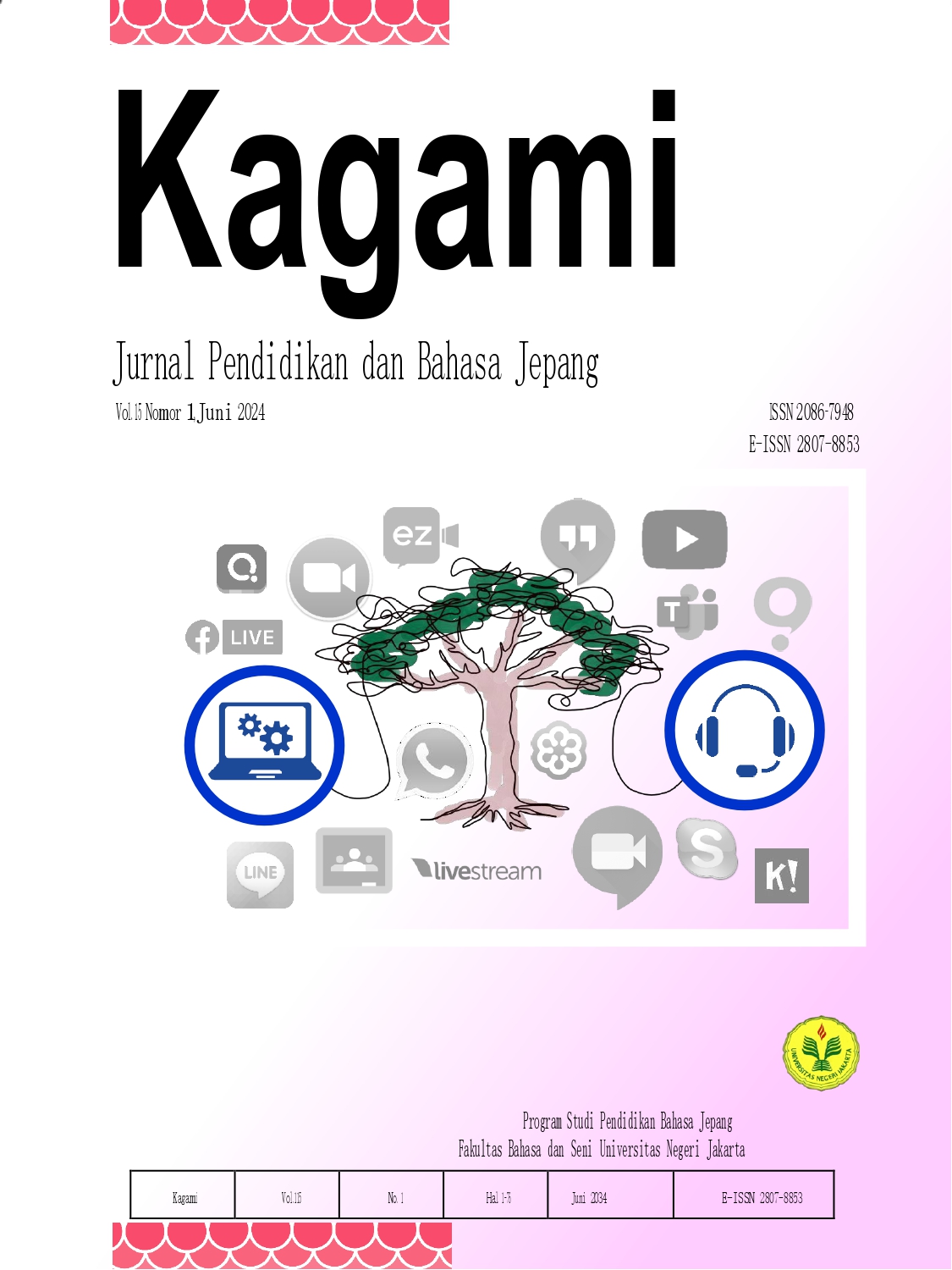PENGARUH PENGGUNAAN WEBSITE “TAN TERHADAP KEMAMPUAN PENGUASAAN KANJI PADA PEMBELAJARAN JARAK JAUH
PENGARUH PENGGUNAAN WEBSITE “TANOSHIIJAPANESE.COM” TERHADAP KEMAMPUAN PENGUASAAN KANJI PADA PEMBELAJARAN JARAK JAUH
DOI:
https://doi.org/10.21009/kagami.151.01Keywords:
Website, kanji, distance learningAbstract
This research discusses the influence of using the website "tanoshiijapanese.com on the ability to master kanji. At the beginning of 2020 a virus emerged that shocked the whole world, namely the corona virus. This virus first appeared in the city of Wuhan, China in December 2019. However, this virus quickly spread throughout the world and attacked all lines or sectors, such as: Education, economy, health, trade and others. One of the sectors that is greatly affected by this virus is education. This sector is one of the toughest apart from the health sector. Because more and more people are being exposed to this virus, all heads of state around the world are changing the learning system from face-to-face to online. The formulation of the problem in this research is: (1) Can the use of the website "tanoshiijapanese.com" improve students' writing skills during distance learning?, (2) Can the use of the website "tanoshiijapanese.com" improve students' writing skills during learning? remotely? The objectives of this research include: (1) Does the website "tanoshiijapanese.com" improve your ability to write kanji during distance learning? (2) Do you know that the website "tanoshiijapanse.com" can improve your ability to read kanji during distance learning? The research method used in this research is quantitative desktop, the population and sample in this research are 22 students from the Japanese language and culture study program at Darma Persada University, Jakarta. From this research, the results were obtained that the website "tanoshiijapanese.com" can improve writing and reading skills during online/distance learning
References
Bahasoan, A. N., Wulan Ayuandiani, Muhammad Mukhram, & Aswar Rahmat. (2020). Effectiveness of Online Learning In Pandemic Covid-19. International Journal of Science, Technology & Management, 1(2), 100–106. https://doi.org/10.46729/ijstm.v1i2.30
Bhagaskara, A. E., Firdausi, A. K., & Syaifuddin, M. (2021). Penerapan Media Webquest Berbasis Google Sites dalam Pembelajaran Masa Pandemi Covid-19 di MI Bilingual Roudlotul Jannah Sidoarjo. Jurnal Bidang Pendidikan Dasar, 5(2), 104–119. https://doi.org/10.21067/jbpd.v5i2.5541
Firmansyah, D. B., & Rahmawati, R. S. (2018). Penggunaan Media Ajar Berbasis Multimedia Dalam Pembelajaran Kanji. JAPANEDU: Jurnal Pendidikan Dan Pengajaran Bahasa Jepang, 3(1), 1. https://doi.org/10.17509/japanedu.v3i1.11239
Harvian, K. A. (2022). ScienceDirect ScienceDirect Public Public sentiment sentiment towards towards face-to-face face-to-face activities activities during during the the COVID-19 COVID-19 pandemic pandemic in in Indonesia Indonesia. Procedia Computer Science, 197(2021), 529–537. https://doi.org/10.1016/j.procs.2021.12.170
Karyati, A., & Rahmawati, Y. (2020). Strategi Pembelajaran Kanji Menggunakan Metode Flipped Class Dengan Media Online “Tanoshiijapanese” Dalam Meningkatkan Kemampuan Kanji Jlpt N3. Seminar Nasional ADPI Mengabdi Untuk Negeri, 1(1), 154–159. https://doi.org/10.47841/adpi.v1i1.44
Karyati, A., & Rahmawati, Y. (2021). Pembelajaran Kanji Menggunakan Metode Flipped classroom dengan Media Online “Tanoshiijapanese.com” dalam Meningkatkan Kemandirian Belajar Siswa. Chi’e: Journal of Japanese Learning and Teaching, 9(1), 70–75. https://doi.org/10.15294/chie.v9i1.45468
Miangah nezarat. (2013). BAHASA JEPANG MENGGUNAKAN MOBILE PHONE BERBASIS ANDROID DAN iOS. School of Computer Science Binus University, 4(2), 1295–1300.
Muhlisian, A. A., & Putri, Y. K. (2019). Penggunaan Media Sosial Instagram dalam Pembelajaran Kanji. Journal of Japanese Language Education and Linguistics, 3(2), 181–191. https://doi.org/10.18196/jjlel.3230
N, N. F., Syarif, S., Ahmad, M., & B, Y. S. (2021). Web-based learning media the skills of suturing rupture perineum of midwifery students. Gaceta Sanitaria, 35, S248–S250. https://doi.org/10.1016/j.gaceta.2021.07.017
Nurmi, N. (2017). Membangun Website Sistem Informasi Dinas Pariwisata. Edik Informatika, 1(2), 1–6. https://doi.org/10.22202/ei.2015.v1i2.1418
Rasiban, L. M. (2021). Web-Based Kanji Characters Learning: Undergraduate Students’ Conception. 518(ICoSIHESS 2020), 398–401. https://doi.org/10.2991/assehr.k.210120.151
Rasiban, L. M., Febriani, M., & Renariah. (2020). Use of Mrs.Kanji Web Application to Enhance Japanese Kanji Learning. 424(April 2019), 353–358. https://doi.org/10.2991/assehr.k.200325.110
Renariah. (2004). Mengingat Kanji melalui Bushu. FOKUS: Jurnal Jurusan Pendidikan Bahasa Asing FPBS UPI, 1(2).
Salsabila, U. H., Rosyidatul Afifah, Rahmawati, H., & Aulia Inayah, R. (2020). Metodologi Pembelajaran Jarak Jauh Terhadap Siswa Kelas V Sd Muhammadiyah Bendo Kalibawang. Jurnal Pendidikan Dasar Dan Keguruan, 5(2), 28–36. https://doi.org/10.47435/jpdk.v5i2.445
Setiawati, N. (2020). Pembelajaran Kanji Ii Di Masa Pandemi Covid-19 Dengan Bantuan Media Edmodo. 9(November), 13–27.
State, T., Teaching, O., Studies, H. E., & Sciences, H. (2022). 大学教員のオンライン授業に関する知識の実態. 46(1).
Suartini, P. M. V. D. N. M. S. M. (2021). Kendala Mahasiswa Angkatan 2019 Dalam Pembelajaran Daring Semester Genap Tahun Ajaran 2019 / 2020 Pada Mata Kuliah Konten Bahasa Jepang Di Universitas Pendidikan Ganesha. Penelitian, Jurnal Indonesia, Mahasiswa, 1(2).
Suryadi, D., & Rosiah, R. (n.d.). Motivasi Belajar Bahasa Jepang Mahasiswa Program Studi Pendidikan Bahasa Jepang Universitas Muhammadiyah Yogyakarta.
Takebe, Y. (1995). Kanji no Oshiekata. NAFL.
Yunita Yunita, E. E. (2021). Problem soving. Pembelajaran Jarak Jauh Dengan Media E-Learning: Diskursus Melalui Problem Soving Di Era Pandemik Covid-19, 2(1), 133–146.
Downloads
Published
Issue
Section
License
Copyright (c) 2024 Alo Karyati

This work is licensed under a Creative Commons Attribution 4.0 International License.





